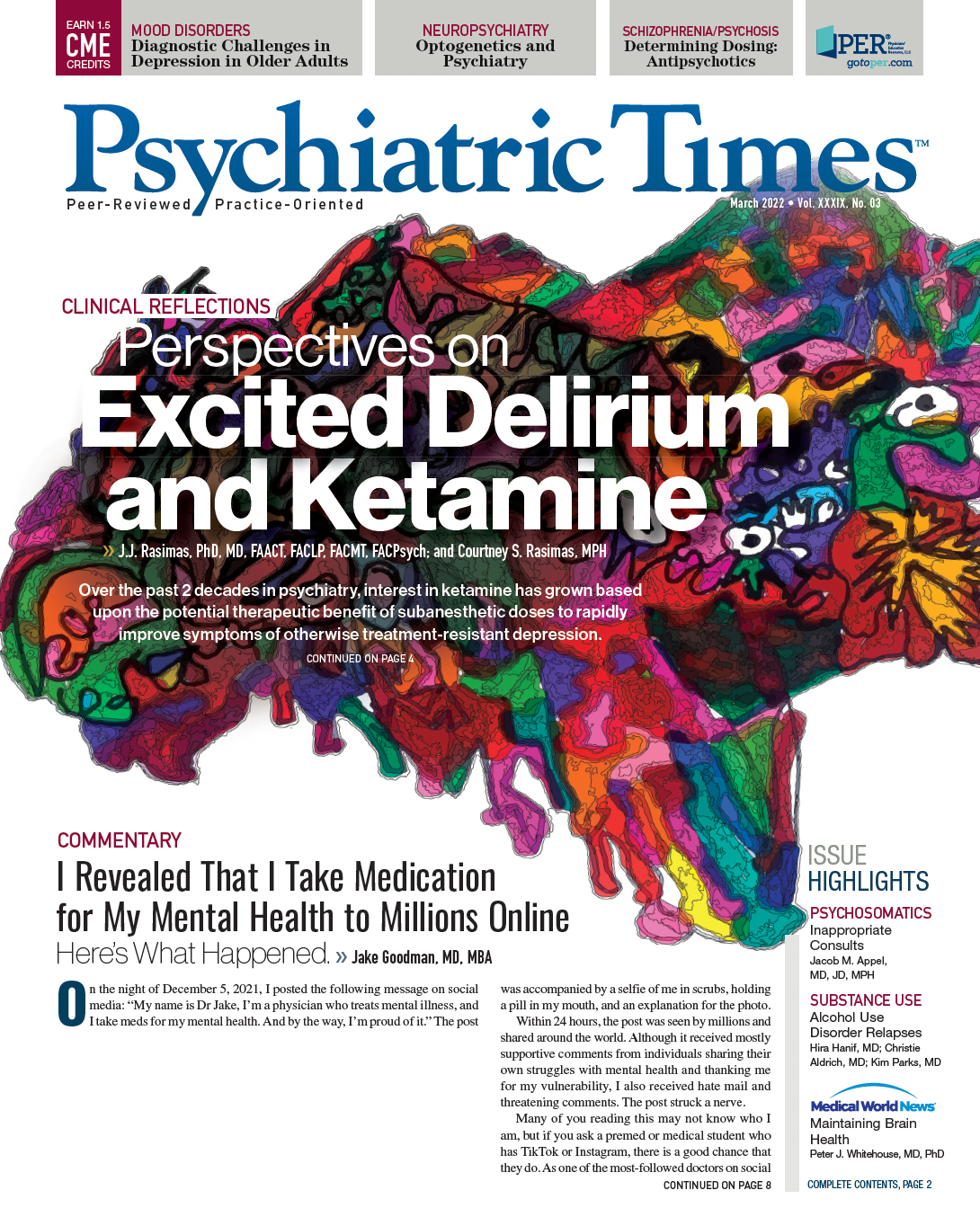CME
Article
Psychiatric Times
The Assessment of Depression Among Older Adults
In this CME article, learn about the best ways to assess depression in the geriatric population.
Khunatorn/AdobeStock

CATEGORY 1 CME
Premiere Date: March 20, 2022
Expiration Date: September 20, 2023
ACTIVITY GOAL
The goal of this activity is to review the epidemiology, risk factors, and evidence-based assessment of depression among older adults.
LEARNING OBJECTIVES
1. To describe the epidemiology and risk factors for depression among older adults
2. To discuss the assessment of depression among older adults
TARGET AUDIENCE
This accredited continuing education (CE) activity is intended for psychiatrists, psychologists, primary care physicians, physician assistants, nurse practitioners, and other health care professionals seeking to improve the care of patients with mental health disorders.
ACCREDITATION/CREDIT DESIGNATION/FINANCIAL SUPPORT
This activity has been planned and implemented in accordance with the accreditation requirements and policies of the Accreditation Council for Continuing Medical Education (ACCME) through the joint providership of Physicians’ Education Resource®, LLC, and Psychiatric Times™. Physicians’ Education Resource®, LLC, is accredited by the ACCME to provide continuing medical education for physicians.
Physicians’ Education Resource®, LLC, designates this enduring material for a maximum of 1.5 AMA PRA Category 1 Credits™. Physicians should claim only the credit commensurate with the extent of their participation in the activity.
This activity is funded entirely by Physicians’ Education Resource®, LLC. No commercial support was received.
OFF-LABEL DISCLOSURE/DISCLAIMER
This accredited CE activity may or may not discuss investigational, unapproved, or off-label use of drugs. Participants are advised to consult prescribing information for any products discussed. The information provided in this accredited CE activity is for continuing medical education purposes only and is not meant to substitute for the independent clinical judgment of a physician relative to diagnostic or treatment options for a specific patient’s medical condition. The opinions expressed in the content are solely those of the individual faculty members and do not reflect those of Physicians’ Education Resource®, LLC.
FACULTY, STAFF, AND PLANNERS’ DISCLOSURES AND CONFLICT OF INTEREST (COI) MITIGATION
The peer reviewer and staff members of Physicians’ Education Resource®, LLC, and Psychiatric Times™ have no relevant financial relationships with commercial interests.
None of the staff of Physicians’ Education Resource®, LLC, or Psychiatric TimesTM, or the planners of this educational activity, have relevant financial relationship(s) to disclose with ineligible companies whose primary business is producing, marketing, selling, reselling, or distributing health care products used by or on patients. The authors do not have any conflicts of interest to disclose for this article.
For content-related questions, email us at PTEditor@mmhgroup.com. For questions concerning the accreditation of this CE activity or how to claim credit, please contact info@gotoper.com and include “The Assessment of Depression Among Older Adults” in the subject line.
HOW TO CLAIM CREDIT
Once you have read the article, please use the following URL to evaluate and request credit: https://education.gotoper.com/activity/ptcme22mar. If you do not already have an account with Physicians’ Education Resource®, LLC, you will be prompted to create one. You must have an account to evaluate and request credit for this activity.
(This is part 1 of a 2-part CME activity discussing depression in older adults.
Part 2 appears in the April issue—Ed.)
According to the DSM-5, major depressive disorder (MDD) is a condition that is characterized by the presence of depressed mood or marked loss of interest or pleasure in activities.1 Other symptoms associated with MDD include changes in sleep, energy, concentration, appetite, weight (changes in 5% of total body weight), and psychomotor activity. Additionally, individuals present with feelings of inappropriate guilt or worthlessness and recurrent thoughts of death or suicide. Furthermore, these symptoms should cause clinically significant distress or impairments in social, occupational, or other areas of functioning. Also, these episodes of depression should not be attributable to the psychological effects of substances or medical conditions. To meet the criteria for an MDD, an individual should have depressed mood or marked loss of interest or pleasure in activities, plus 4 associated symptoms. These symptoms should have occurred during the same 2-week period.
Table 1. Prevalence Rates for Depression Among Older Adults

The term late-life depression (LLD) is specifically used to describe depression that occurs among individuals 65 years or older who do not have a previous history of depression.2 Table 1 describes the prevalence rates for depression among older adults.3-6
Presentation
The presentation of MDD in older adults differs from the presentation of MDD among younger adults.3,7 Table 2 highlights the differences between MDD in older adults vs younger adults.3,7-9
Table 2. Differences Between MDD in Older Adults vs Younger Adults
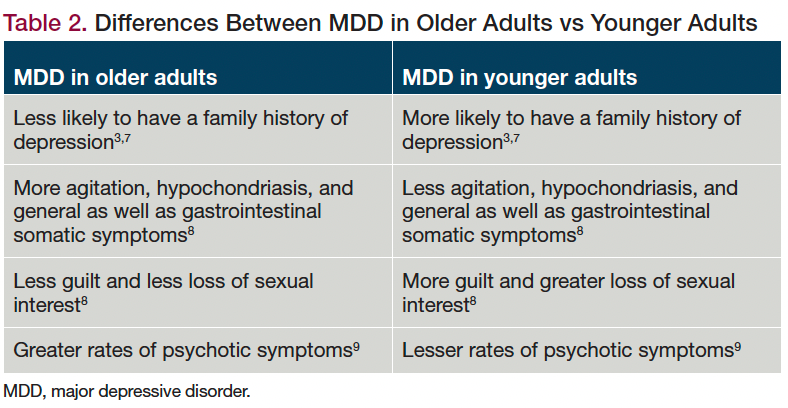
Psychotic Depression
MDD with psychotic symptoms accounts for approximately 25% to 50% of admissions to inpatient geriatric psychiatry units.10 Nihilistic, somatic, or poverty-based delusions are often seen among older adults with MDD. These individuals also have greater rates of insomnia, somatic symptoms, diurnal variation of mood, and poor insight into their illness.3,10 Among older individuals with MDD, hallucinations appear to occur less frequently than delusions.
The risk factors for the development of psychotic symptoms among older adults with MDD include being single, widowed, or living alone.10 The presence of psychotic symptoms in older patients with MDD is a poor prognostic factor. These individuals present with frequent recurrences of symptoms that result in hospitalizations.3 Age-related deterioration of the cortical areas of the brain, neurochemical changes commonly seen with aging, comorbid medical conditions, social isolation, sensory deficits, cognitive decline, and polypharmacy are all considered possible reasons for the occurrence of psychotic symptoms among older adults with MDD.9
Relationship Between Depression and Dementia
Depression and dementia in older adults have a similar presentation and share an important relationship.11,12 Older adults with MDD are more likely to develop cognitive deficits when compared with their age- and education-matched counterparts without depression.13-15 Approximately 20% to 50% of older adults with depression develop cognitive deficits, including executive dysfunction and deficits in information processing and visuospatial functioning.13-15 Depressive pseudodementia or depression-associated dementia are the reversible cognitive deficits that are often seen during an episode of depression and that tend to improve with the treatment of the depressive episode.2,4
Table 3. Symptoms of Depression-Associated Dementia Compared With Primary Dementia17
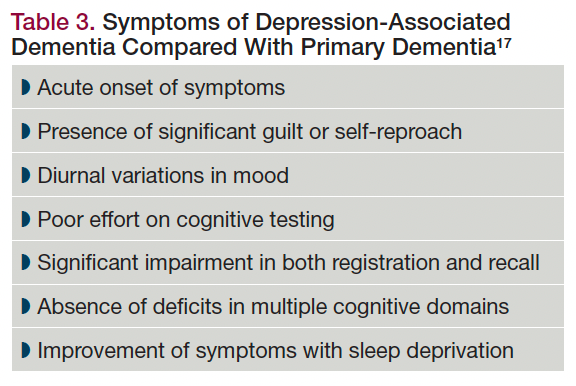
Often, the occurrence of depressive symptoms can be the presenting symptom of dementia in this patient population. It is still unclear from available evidence whether an episode of depression is a prodrome for the onset of dementia, a risk factor for dementia, or an independent event.16 Table 3 describes the symptoms that primarily occur among individuals with depression-associated dementia when compared with a primary dementia.17
Neurobiology
Table 4. Biological, Psychological, and Sociological Factors That May Result in Depression Among Older Adults
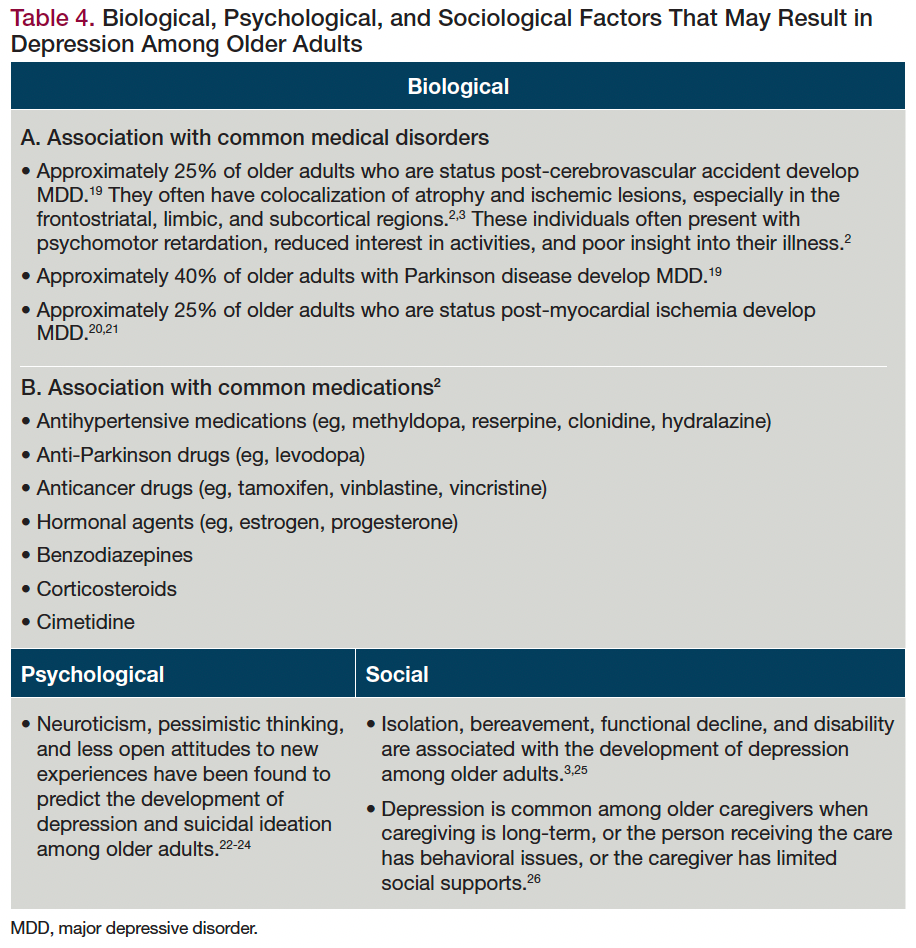
Current evidence indicates that LLD occurs due to the complex interactions among the various biological, psychological, and sociological factors seen among older adults.18 Table 4 describes the various biological, psychological, and sociological factors that result in the development of depression among older adults.19-26
Available evidence indicates that the impact of psychosocial risk factors on depression among older adults can be altered by personal or environmental factors.26 One meta-analysis noted that the important risk factors for the development of depression among older community-dwelling individuals include a prior history of depression, female gender, sleep disturbance, bereavement, and the presence of disability.27
Consequences
Table 5. Medical, Social, and Societal Consequences of Depression in Older Adults

As with younger patients, depression among older adults can result in various poor outcomes. Older adults with depression have 1.5 to 3 times greater morbidity when compared with older adults without depression.1 Table 5 describes the medical, social, and societal consequences of depression in older adults.28-37
Assessment
Current evidence indicates that almost 50% of older adults who have MDD go undiagnosed; a major reason for this is that the initial evaluation of these individuals for psychiatric symptoms is often completed by their primary physician rather than a psychiatrist.38,39 Additionally, many of these individuals do not report depressive symptoms; instead, they present with somatic complaints, cognitive difficulties, and/or functional changes.33 Any older adult who presents with these symptoms should always be screened for possible depression.
The assessment of depression among older adults starts with a thorough history, which should be obtained from the patient and, if possible, a knowledgeable informant.3 In addition, these individuals should have a comprehensive medical and psychosocial assessment. There should also be a suicide risk assessment, a cognitive screening, and a functional evaluation.
Table 6. Salient Features of Rating Instruments for Depression Among Older Adults40
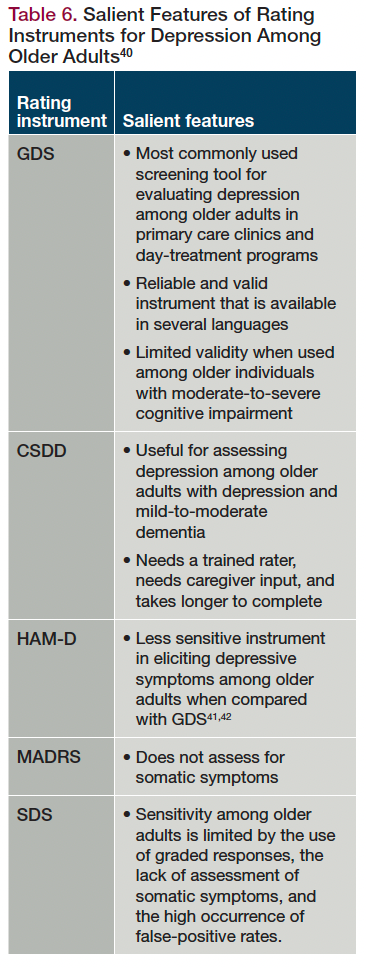
The use of standardized screening instruments can assist with the diagnosis of depression and the screening for suicide.40 In addition, these instruments can help with assessing the severity of depression, identifying psychotic symptoms, and assessing treatment responses. The common screening tools for depression in older adults are the Geriatric Depression Scale (GDS), the Cornell Scale for Depression in Dementia (CSDD), the Hamilton Rating Scale for Depression (HAM-D), the Montgomery-Asberg Depression Rating Scale (MADRS), and the Zung Self-Rating Depression Scale (SDS). The Brief Psychiatric Rating Scale is the most commonly used scale to detect and rate the severity of psychopathology among older adults with depression and psychotic symptoms. Table 6 discusses the salient features of these rating instruments.40-42
A thorough physical examination is an important part of the assessment, as these individuals have greater rates of medical comorbidities when compared with age-matched controls.37 Table 7 specifies the medical workup for older adults with depression.43-45
Prognosis
Evidence indicates that depression is a chronic and relapsing illness.46 Although approximately 25% of older adults with depression will achieve full remission with or without any treatment, another 25% will never achieve any treatment response.3 The remaining 50% will have a waxing-and-waning course. Poor prognostic factors include the presence of psychotic features, comorbid medical illness, physical disability, and a lack of social supports.3,10 The presence of medical comorbidities is a major risk factor for poor treatment response and poor antidepressant tolerability among these individuals.46
Table 7. Medical Workup for Older Adults With Depression43-45
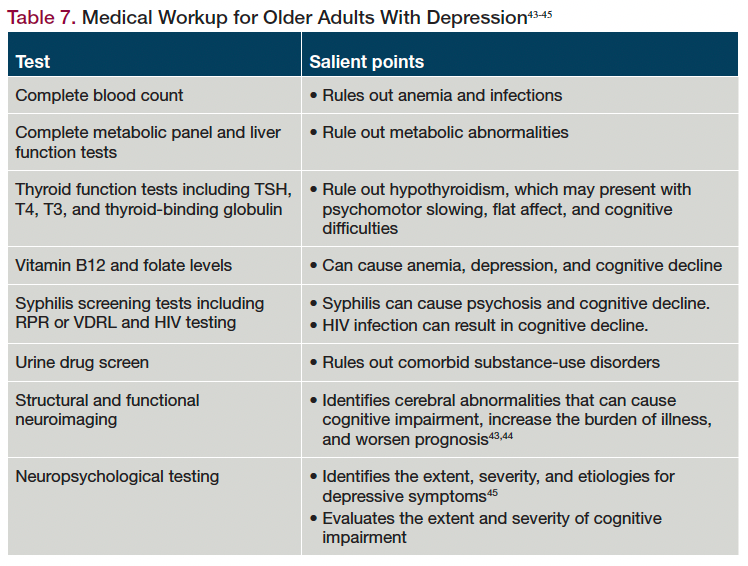
Conclusions
Evidence indicates that depression is not an uncommon condition among older adults. Depression is often underdiagnosed in this patient population and is associated with poorer outcomes, including greater rates of morbidity and mortality. A thorough history should include ruling out medical causes and drug effects; a focused physical examination; and appropriate laboratory studies, including neuroimaging and neuropsychological testing when necessary, as these are important in identifying depression among older adults.
Depression remains a chronic and relapsing illness, with approximately half of the individuals having a waxing-and-waning course. The presence of psychotic symptoms, medical comorbidities, and physical disability, and the absence of social supports, worsen prognosis for depression among older adults.
Dr Tampi is professor and chairman, Department of Psychiatry, Creighton University School of Medicine and Catholic Health Initiatives (CHI) Health Behavioral Health Services, Omaha, Nebraska. He is also an adjunct professor of psychiatry at Yale School of Medicine. Ms Tampi is cofounder and managing principal, Behavioral Health Advisory Group, Princeton, New Jersey.
References
1. Depressive disorders. In: American Psychiatric Association. Desk Reference to the Diagnostic Criteria From DSM-5. American Psychiatric Publishing; 2013:93-114.
2. Alexopoulos GS. Depression in the elderly. Lancet. 2005;365(9475):1961-1970.
3. Fountoulakis KN, O’Hara R, Iacovides A, et al. Unipolar late-onset depression: a comprehensive review. Ann Gen Hosp Psychiatry. 2003;2(1):11.
4. Alexopoulos GS. New concepts for prevention and treatment of late-life depression. Am J Psychiatry. 2001;158(6):835-838.
5. Harman JS, Schulberg HC, Mulsant BH, Reynolds CF III. The effect of patient and visit characteristics on diagnosis of depression in primary care. J Fam Pract. 2001;50(12):1068.
6. Taylor WD, Doraiswamy PM. A systematic review of antidepressant placebo-controlled trials for geriatric depression: limitations of current data and directions for the future. Neuropsychopharmacology. 2004;29(12):2285-2299.
7. Dunner DL. Treatment considerations for depression in the elderly. CNS Spectr. 2003;8(12 Suppl 3):14-19.
8. Hegeman JM, Kok RM, van der Mast RC, Giltay EJ. Phenomenology of depression in older compared with younger adults: meta-analysis. Br J Psychiatry. 2012;200(4):275-281.
9. Thorpe L. The treatment of psychotic disorders in late life. Can J Psychiatry. 1997;42 Suppl 1:19S-27S.
10. Gournellis R, Lykouras L, Fortos A, et al. Psychotic (delusional) major depression in late life: a clinical study. Int J Geriatr Psychiatry. 2001;16(11):1085-1091.
11. Raskind MA. The clinical interface of depression and dementia. J Clin Psychiatry. 1998;59 Suppl 10:9-12.
12. Wang S, Blazer DG. Depression and cognition in the elderly. Annu Rev Clin Psychol. 2015;11:331-360.
13. Yaffe K, Blackwell T, Gore R, et al. Depressive symptoms and cognitive decline in nondemented elderly women: a prospective study. Arch Gen Psychiatry. 1999;56(5):425-430.
14. Comijs HC, Jonker C, Beckman AT, Deeg DJ. The association between depressive symptoms and cognitive decline in community-dwelling elderly persons. Int J Geriatr Psychiatry. 2001;16(4):361-367.
15. Wilson RS, Barnes LL, Mendes de Leon CF, et al. Depressive symptoms, cognitive decline, and risk of AD in older persons. Neurology. 2002;59(3):364-370.
16. Bennett S, Thomas AJ. Depression and dementia: cause, consequence or coincidence? Maturitas. 2014;79(2):184-190.
17. Reynolds CF III, Smith GS, Dew MA, et al. Accelerating symptom-reduction in late-life depression: a double-blind, randomized, placebo-controlled trial of sleep deprivation. Am J Geriatr Psychiatry. 2005;13(5):353-358.
18. Weisenbach SL, Kumar A. Current understanding of the neurobiology and longitudinal course of geriatric depression. Curr Psychiatry Rep. 2014;16(9):463.
19. Alexopoulos GS, Katz IR, Reynolds CF III, et al. Pharmacotherapy of depression in older patients: a summary of the expert consensus guidelines. J Psychiatr Pract. 2001;7(6):361-376.
20. Frasure-Smith N, Lespérance F, Talajic M. Depression following myocardial infarction. impact on 6-month survival. JAMA. 1993;270(15):1819-1825.
21. Carney RM, Freedland KE. Depression, mortality, and medical morbidity in patients with coronary heart disease. Biol Psychiatry. 2003;54(3):241-247.
22. Katon W, Lin E, von Korff M, et al. The predictors of persistence of depression in primary care. J Affect Disord. 1994;31(2):81-90.
23. Lynch TR, Johnson CS, Mendelson T, et al. New onset and remission of suicidal ideation among a depressed adult sample. J Affect Disord. 1999;56(1):49-54.
24. Duberstein PR. Openness to experience and completed suicide across the second half of life. Int Psychogeriatr. 1995;7(2):183-198.
25. Bruce ML. Psychosocial risk factors for depressive disorders in late life. Biol Psychiatry. 2002;52(3):175-184.
26. Clyburn LD, Stones MJ, Hadjistavropoulos T, Tuokko H. Predicting caregiver burden and depression in Alzheimer’s disease. J Gerontol B Psychol Sci Soc Sci. 2000;55(1):S2-S13.
27. Cole MG, Dendukuri N. Risk factors for depression among elderly community subjects: a systematic review and meta-analysis. Am J Psychiatry. 2003;160(6):1147-1156.
28. Goff VV. Depression: a decade of progress, more to do. NHPF Issue Brief. 2002;(786):1-14.
29. Hall CA, Reynolds CF III. Late-life depression in the primary care setting: challenges, collaborative care, and prevention. Maturitas. 2014;79(2):147-152.
30. Michelson D, Stratakis C, Hill L, et al. Bone mineral density in women with depression. N Engl J Med. 1996;335(16):1176-1181.
31. Ferketich AK, Schwartzbaum JA, Frid DJ, Moeschberger ML. Depression as an antecedent to heart disease among women and men in the NHANES I study. National Health and Nutrition Examination Survey. Arch Intern Med. 2000;160(9):1261-1268.
32. Diniz BS, Butters MA, Albert SM, et al. Late-life depression and risk of vascular dementia and Alzheimer’s disease: systematic review and meta-analysis of community-based cohort studies. Br J Psychiatry. 2013;202(5):329-335.
33. Glover J, Srinivasan S. Assessment of the person with late-life depression. Psychiatr Clin North Am. 2013;36(4):545-560.
34. Greenberg PE, Kessler RC, Birnbaum HG, et al. The economic burden of depression in the United States: how did it change between 1990 and 2000? J Clin Psychiatry. 2003;64(12):1465-1475.
35. Turvey CL, Conwell Y, Jones MP, et al. Risk factors for late-life suicide: a prospective, community-based study. Am J Geriatr Psychiatry. 2002;10(4):398-406.
36. Johnson J, Weissman MM, Klerman GL. Service utilization and social morbidity associated with depressive symptoms in the community. JAMA. 1992;267(11):1478-1483.
37. Croghan TW, Obenchain RL, Crown WE. What does treatment of depression really cost? Health Aff (Millwood). 1998;17(4):198-208.
38. Mulsant BH, Ganguli M. Epidemiology and diagnosis of depression in late life. J Clin Psychiatry. 1999;60 Suppl 20:9-15.
39. Unützer J, Katon W, Russo J, et al. Patterns of care for depressed older adults in a large-staff model HMO. Am J Geriatr Psychiatry. 1999;7(3):235-243.
40. Mulkeen A, Zdanys K, Muralee S, Tampi RR. Screening tools for late-life depression: a review. Depression: Mind and Body. 2008;3(4):150-157.
41. Lichtenberg PA, Marcopulos BA, Steiner DA, Tabscott JA. Comparison of the Hamilton Depression Rating Scale and the Geriatric Depression Scale: detection of depression in dementia patients. Psychol Rep. 1992;70(2):515-521.
42. Clayton A, Holroyd S, Sheldon-Keller A. Geriatric Depression Scale vs Hamilton Rating Scale for Depression in a sample of anxiety patients. Clin Gerontologist. 1997;17:3-13.
43. Benjamin S, Steffens DC. Structural neuroimaging of geriatric depression. Psychiatr Clin North Am. 2011;34(2):423-435, ix.
44. Gunning FM, Smith GS. Functional neuroimaging in geriatric depression. Psychiatr Clin North Am. 2011;34(2):403-422, viii.
45. McClintock SM, Minto L, Denney DA, et al. Clinical neuropsychological evaluation in older adults with major depressive disorder. Curr Psychiatry Rep. 2021;23(9):55.
46. Mitchell AJ, Subramaniam H. Prognosis of depression in old age compared to middle age: a systematic review of comparative studies. Am J Psychiatry. 2005;162(9):1588-1601. ❒
